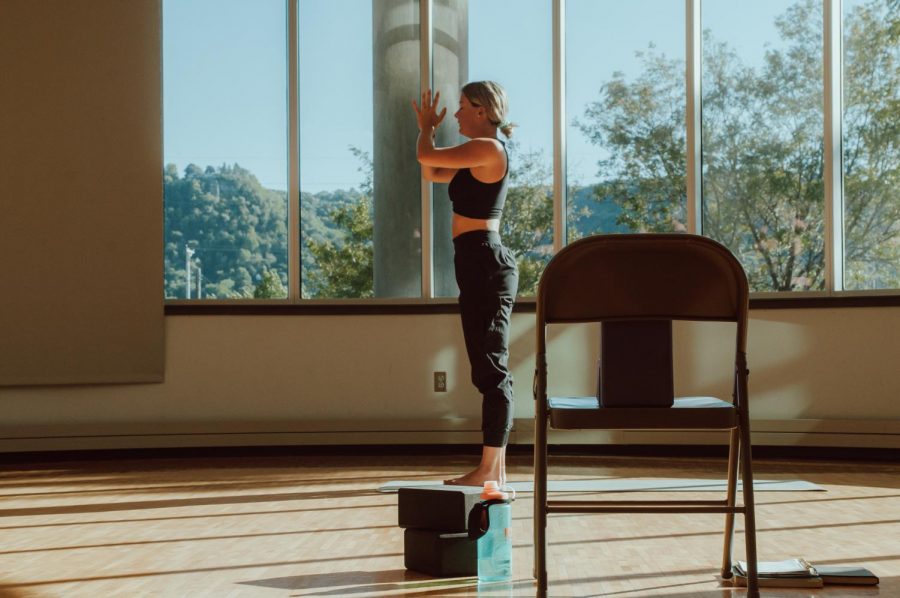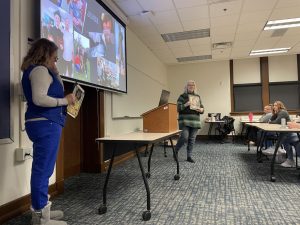Fitness Center Adjusts to COVID-19
Josephine Osowski, lead fitness instructor for Winona State, taking a virtual yoga class at IWC, on Thursday, Sept. 3. Winona State University elected to open the fitness center with prescriptive guidelines from the Minnesota Department of Health and Center for Disease Control and Prevention (CDC).
September 9, 2020
In an effort to keep Winona State University’s student body healthy, the school elected to open the fitness center with prescriptive guidelines from the Minnesota Department of Health and Center for Disease Control and Prevention (CDC).
According to an Aug. 13 article from the CDC, gym and fitness center staff could come at a higher risk of exposure as a result of exercise-induced heavy breathing.
Eric Weigel, associate director of strength & conditioning/fitness for Winona State Athletics, discussed the day-to-day-operations of the Integrated Wellness Complex (IWC).
“There have been obstacles, but we’ve handled the ones presented to us very well,” Weigel said.
In the fitness center, a 12-foot berth of social distancing is required to allot for elevated breathing. With this rule in mind, the maximum capacity for each floor of the fitness center has lowered.
The first floor can safely hold the most people with about 30 students and the third floor can hold five people on stationary bikes.
The dress code was modified to include masks and does not permit deep cut-off workout tanks or shirts with exposed midriff to “limit skin-to-skin contact from machines”.
Prior to the COVID-19 pandemic, students could bounce between machines to complete a workout. Now, the exercise set must be completed in one use. Sanitation before and after each machine use is required.
Although students can bring gym equipment bags to the center, they must be stored in cubbies, as lockers are not open for use.
Similarly, students are encouraged to bring full water bottles from home, as there is limited use of water fountains allowed.
In terms of operational hours, students who choose to use the fitness center must make a reservation through the EMS room reservation service.
Students are given a one-hour window but must complete a workout within 45 minutes.
This scheduling allows student workers, who are scheduled in work pods, to assist with contact tracing, sanitize and prepare for future students. The scheduling also limits potential interactions between gym users and employees, according to Weigel.
The EMS reservation also assists with contract tracing of individuals who have worked out in the center.
For Weigel, the biggest shift in the fitness center comes from the level of interpersonal interactions.
“The weight room and gym are usually social. It’s a place to talk and hang out. Now, students come in, keep their head down and do their own thing,” Weigel said. “Overall, people are happy to be back in a gym setting and have followed rules and precautions.”
Intramural sports have also been affected by COVID.
Mark Bambenek, director of intramural and recreational sports, said that COVID has greatly impacted the purpose of intramurals, which is to unite students in fun, active lifestyles.
Bambenek also oversees the pools in Lourdes Hall on West Campus and Memorial Hall on Main Campus, which, as of now, will not be open for lap or leisure swim for the fall semester.
This decision also impacted athletic trainers who used the pool for rehab, fundamental kayak classes and the community swim lessons which brought in up to 600 swimmers.
Seniors Josephine Osowski and Emma Herbeck were affected by the plan to move primarily online as fitness center instructors.
Osowski, elementary education and early childhood major with a reading instruction minor, has been the lead fitness instructor for the past two years. She has also taught yoga for the past three years and now works closely with Bambenek to formulate ways to access students interested in fitness classes, despite the limitations of the pandemic.
This system includes a scannable QR code to find instructors’ contact information and class descriptions. Students who would like to take an in-person fitness class can connect with instructors through email or their personal class Facebook page where videos are live-streamed.
Additionally, students can stay up to date by following the WSUFitness Facebook page.
The maximum participants for in-person fitness classes is four people. While participating in face-
to-face classes, students must sanitize before and after use of the space and personal equipment.
For Osowski, the decision to keep the fitness center open was a positive one.
Herbeck, a movement science major and adventure education andnutrition minor, teaches STRONG NATION which focuses on high intensity interval training (HIIT) exercises to engage body weight, muscle conditioning and cardio all set to music.
Because classes are facilitated digitally, she said people can easier accommodate their workouts into schedules.
“In this day and age, being able to escape or shift focus can be very beneficial to overall health,” Herbeck said.
Bambenek commented how he believed people adapting to current conditions has been amazing.
“Fitness is a big part of people’s lives. People want a chance to grab things that they’re missing right now,” Bambenek said. “When we’re cleared, we’re ready to go, ready to work and play all while following the rules.”
The opinions expressed in this paper are not necessarily those of Winona State University, the Minnesota State Colleges and University system, or the Winona State University student body.



































